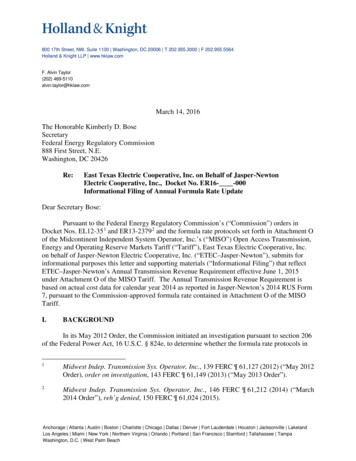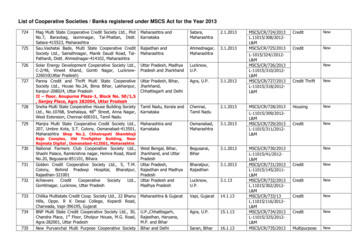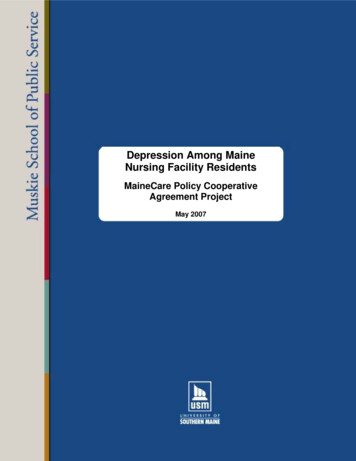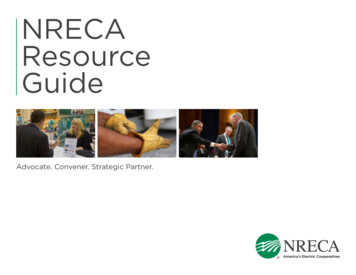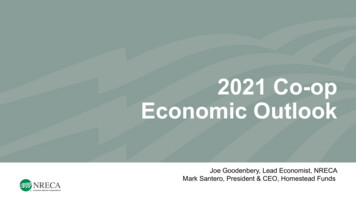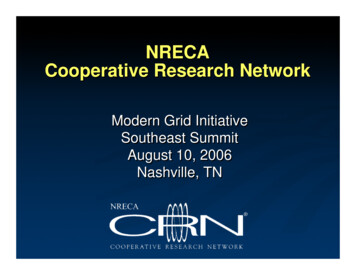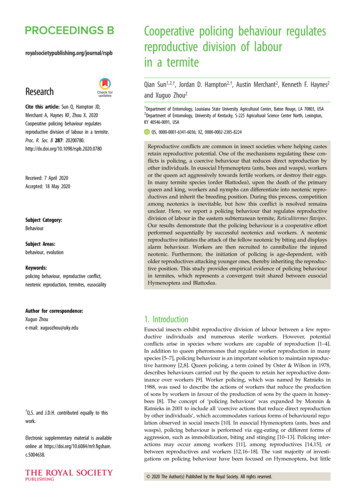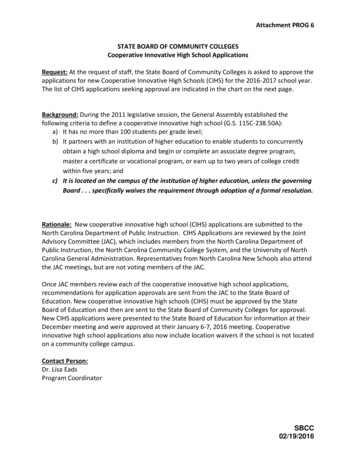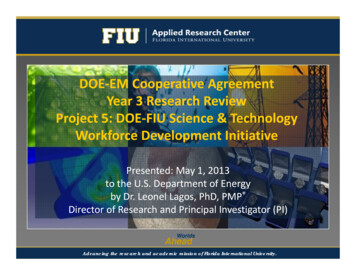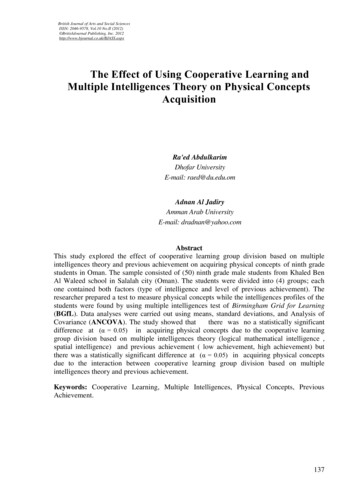
Transcription
British Journal of Arts and Social SciencesISSN: 2046-9578, Vol.10 No.II (2012) BritishJournal Publishing, Inc. 2012http://www.bjournal.co.uk/BJASS.aspxThe Effect of Using Cooperative Learning andMultiple Intelligences Theory on Physical ConceptsAcquisitionRa'ed AbdulkarimDhofar UniversityE-mail: raed@du.edu.omAdnan Al JadiryAmman Arab UniversityE-mail: dradnan@yahoo.comAbstractThis study explored the effect of cooperative learning group division based on multipleintelligences theory and previous achievement on acquiring physical concepts of ninth gradestudents in Oman. The sample consisted of (50) ninth grade male students from Khaled BenAl Waleed school in Salalah city (Oman). The students were divided into (4) groups; eachone contained both factors (type of intelligence and level of previous achievement). Theresearcher prepared a test to measure physical concepts while the intelligences profiles of thestudents were found by using multiple intelligences test of Birmingham Grid for Learning(BGfL). Data analyses were carried out using means, standard deviations, and Analysis ofCovariance (ANCOVA). The study showed thatthere was no a statistically significantdifference at )α .0.0( in acquiring physical concepts due to the cooperative learninggroup division based on multiple intelligences theory (logical mathematical intelligence ,spatial intelligence) and previous achievement ( low achievement, high achievement) butthere was a statistically significant difference at )α .0.0( in acquiring physical conceptsdue to the interaction between cooperative learning group division based on multipleintelligences theory and previous achievement.Keywords: Cooperative Learning, Multiple Intelligences, Physical Concepts, PreviousAchievement.137
British Journal of Arts and Social SciencesISSN: 2046-9578,1. Introduction:Over the last 50 years science curriculum has shown a remarkable development. Thatwas urgent and necessary requirement to meet the challenges that have emerged after the endof the Second World War. Khataibh (2005) reported that United State of America has spentmore than (2) billion U.S. in support of science and mathematics education in primary andsecondary schools. The main objective was preparing future scientists and engineers.Science curriculum should focus mainly on building and developing scientificconcepts structure of the learners. Much more attention should be paid to the proper practiceof science process skills. Scientific concepts and science processes skills play a vital role inhelping students to solve problems and explain phenomena through the interaction betweenfacts and concepts. Educational process is no longer limited to providing the students withknowledge and facts but also to develop their scientific thinking rapidly day by day (Zaitoon,2000).The interest in scientific concepts stems from the fact that they make the learningmeaningful. Concepts are often settled in long-term memory of the learner, which enableslearners to earn long preservation of knowledge (Mohaisen, 1999).Nashawati (2003) suggests that learning must be directed to the development ofscientific concepts because they compose essential base of the more complex cognitivebehavior. Learning scientific concepts is one of the educational goals that the school shouldtry to achieve.Zaitoon (2001) divided the scientific concept into two parts: the first part is the word(term), phrase or a specific process while the second part is the meaning or the understandingassociated with the first part (mammals: animals with breasts and her body covered with hair).Khtaibeh (2005) reported that the scientific concepts are one of the most important aspectsof learning science because of their importance in organizing any scientific experience ormemorizing knowledge. .1.1 Study Questions1. What is the effect of cooperative learning group division based on multipleintelligences theory (logical mathematical intelligence, spatial intelligence) onphysical concepts acquisition of ninth grade students in Oman?2. What is the effect of cooperative learning group division based on previousachievement (low achievement, high achievement) on physical concepts acquisition ofninth grade students in Oman?3. What is the effect of the interaction between cooperative learning group division basedon multiple intelligences theory and previous achievement on physical conceptsacquisition of ninth grade students in Oman?1.2 Purpose of the StudyThe main purpose of the study is to investigate the effect of cooperative learninggroup division based on multiple intelligences theory and previous achievement on physicalconcepts acquisition of ninth grade students in Oman?1.3 Significance of the StudyThis study is significant because it suggests a new standard for the division ofcooperative learning groups based on the theory of multiple intelligences. In the proposedstandard, the students in each group are strong and distinguished in a specific intelligencewhile the combination of intelligence for each learner may completely differs from the otherlearners in the same group. This offers a novel approach to an integrated homogeneous groupsin terms of distinguished intelligence and non-homogeneous in terms of the overall138
British Journal of Arts and Social SciencesISSN: 2046-9578,combination of the intelligence0 It therefore suggests a new trend in cooperative learning canbe called smart cooperative learning or intelligent cooperative learning.The use of the theory of multiple intelligences in the cooperative learning offer a newinsight into the tasks that are assigned to students, where each student has a task or multipletasks fit with the profile of intelligence he has. The student will be better able to accomplishthe task and therefore possessing a feeling of success and achievement. This is completelyconsistent with what Gardner said "It is of the utmost importance that we recognize andnurture all of the varied human intelligences, and all of the combinations of intelligences. Weare all so different largely because we all have different combinations of intelligences. If werecognize this, I think we will have at least a better chance of dealing appropriately with themany problems that we face in the world" (Armstrong, 2009:5).1.4 Study Hypotheses1.There is no statistically significant difference at )α .0.0( in physical conceptsacquisition of ninth grade students attributed to the cooperative learning group division basedon multiple intelligences theory (logical mathematical intelligence , spatial intelligence).2. There is no statistically significant difference at )α .0.0( in physical conceptsacquisition of ninth grade students attributed to the cooperative learning group division basedon previous achievement (low achievement, high achievement).3.There is no statistically significant difference at )α .0.0( in physical conceptsacquisition of ninth grade students attributed to the interaction between cooperative learninggroup division based on multiple intelligences theory and previous achievement.1.5 Study LimitationsThe generalization of the findings of this study will be limited by: Sample of male students in the ninth grade in the province of Dhofar.Two chapters of science textbook of ninth-grade in Oman ( eclectic charge &energy transformation)Using cooperative learning strategy: "Think-Pair-Share", which means (think ofyour own and then share your answers with your partner and then share youranswers with the class as a whole).The validity and reliability of instruments used in the study.Division of cooperative learning groups according to two kinds of intelligences(logical-mathematical intelligence, visual spatial intelligence) and on previousachievement (low achievement, high achievement).1.6 Operational Definitions of Study’s TerminologyThis study involved a set of terms: theory of multiple intelligences (which includedlogical mathematical intelligence and visual spatial intelligence), academic achievement, andscientific thinking skills.Theory of Multiple Intelligences: The theory developed was in 1983 by Dr. HowardGardner. The theory challenged traditional beliefs in the fields of education and cognitivescience. According to this theory, human beings have eight different kinds of intelligence thatreflect different ways of interacting with the world. Each person has a unique combination, orprofile. Although we have all eight intelligences, no two individuals have them in the sameexact configuration.The Logical Mathematical Intelligence: The capacity to understand the underlyingprinciples of some kind of causal system, the way a scientist or a logician does; or to139
British Journal of Arts and Social SciencesISSN: 2046-9578,manipulate numbers, quantities, and operations, the way a mathematician does. In this study,logical-mathematical intelligence is measured by the test of multiple intelligences.Spatial intelligence: The ability to represent the spatial world internally in your mind,the way a sailor or airplane pilot navigates the large spatial world, or the way a chess playeror sculptor represents a more circumscribed spatial world. Spatial intelligence can be used inthe arts or in the sciences. In this study, spatial intelligence is measured by the test of multipleintelligences.Previous academic achievement: Is the outcome that the student can access to whileachieving the educational goal, and it is measured by student mark in science in the previousacademic year preceding the study. Previous academic achievement has been divided into twocategories:High achievement category, which includes marks from 80% - 100%Low achievement category, which includes marks from 50% - 70%.Physical Concepts Acquisition:It is defined as an individual's ability to configure coherent format of the basic andsecondary concepts and to give a clear perception of the physical concepts in terms ofdefinition, characteristics and distinguishing them from other concepts besides the relationsbetween them. Also it reflects the degree to which the individual digest the new knowledge.Acquiring physical concepts will be measured by the physical concepts test prepared by theresearcher.2.1 Theoretical Literature2.1.1 Cooperative Learning: Vygotsky (1978) suggested that people do not learn inisolation from others, they naturally learn and work cooperatively throughout their lives.Cooperative learning is defined differently by different researchers and theorists. Vygotsky,for example views cooperative learning as a part of a process leading to the socialconstruction of knowledge. Christison (1990) defined cooperative learning as a strategy usedto increase the descriptive motivation and attention to help students develop a positiveconcept of themselves and the other students, while Oslen and Kagan (1992) saw cooperativelearning as a learning activity in which learning is dependent on the social composition of themutual information between learners in groups so that each learner is responsible for hislearning.Lee (1990) considers cooperative learning as a group working together to perform atask or skill to make any attempt to learn and to achieve educational goals in common, whileJohnson, Johnson, & Holubec (1993) defined cooperative learning as the instructional use ofsmall groups so that students work together to maximize their own and each other’s learning.Johnson and Johnson Model (1999) includes five criteria that define true cooperative learninggroups: Positive interdependence: members understand that they must learn together toaccomplish the goal; they need each other for support, explanations, and guidance. Individual accountability: the performance of each group member is assessed against astandard, and members are held responsible for their contribution to achieving goals. Face-to-face interaction: students interact face-to-face and close together, not across theroom. Group processing: groups reflect on their collaborative efforts and decide on ways toimprove effectiveness. Development of small- group interpersonal skills: these skills, such as giving constructivefeedback, reaching consensus, and involving every member, are necessary for effective140
British Journal of Arts and Social SciencesISSN: 2046-9578,group functioning. They must be taught and practiced before the groups tackle a learningtask.2.1.2. Multiple Intelligences: Gardner's TheoryHoward Gardner (1983) proposed a new view of intelligence that is rapidly beingincorporated in school curricula. In his Theory of Multiple Intelligences, Gardner expandedthe concept of intelligence to also include areas such as music, spatial relations, andinterpersonal knowledge in addition to mathematical and linguistic ability.Gardner defines intelligence as “the capacity to solve problems or to fashion productsthat are valued in one or more cultural setting" (Gardner & Hatch, 1989:4). Using biologicalas well as cultural research, he formulated a list of seven intelligences. This new outlook onintelligence differs greatly from the traditional view which usually recognizes only twointelligences, verbal and computational.Gardner set up certain basic “tests” that each intelligence had to meet to be considereda full-fledged intelligence not simply a talent, skill, or aptitude. The criteria he used includethe following factors: Potential isolation by brain damage.The existence of savants, prodigies and other exceptional individuals. An identifiable core operation or set of operations. A distinctive development history, along with a definable set of 'end-state'performances. An evolutionary history and evolutionary plausibility. Support from experimental psychological tasks. Support from psychometric findings. Susceptibility to encoding in a symbol system. (Armstrong, 2009)Howard Gardner initially formulated a list of seven intelligences. His listing wasprovisional. The first two have been typically valued in schools; the next three are usually
This study involved a set of terms: theory of multiple intelligences (which included logical mathematical intelligence and visual spatial intelligence), academic achievement, and scientific thinking skills. Theory of Multiple Intelligences: The theory developed was in 1983 by Dr. Howard Gardner. The theory challenged traditional beliefs in the fields of education and cognitive

